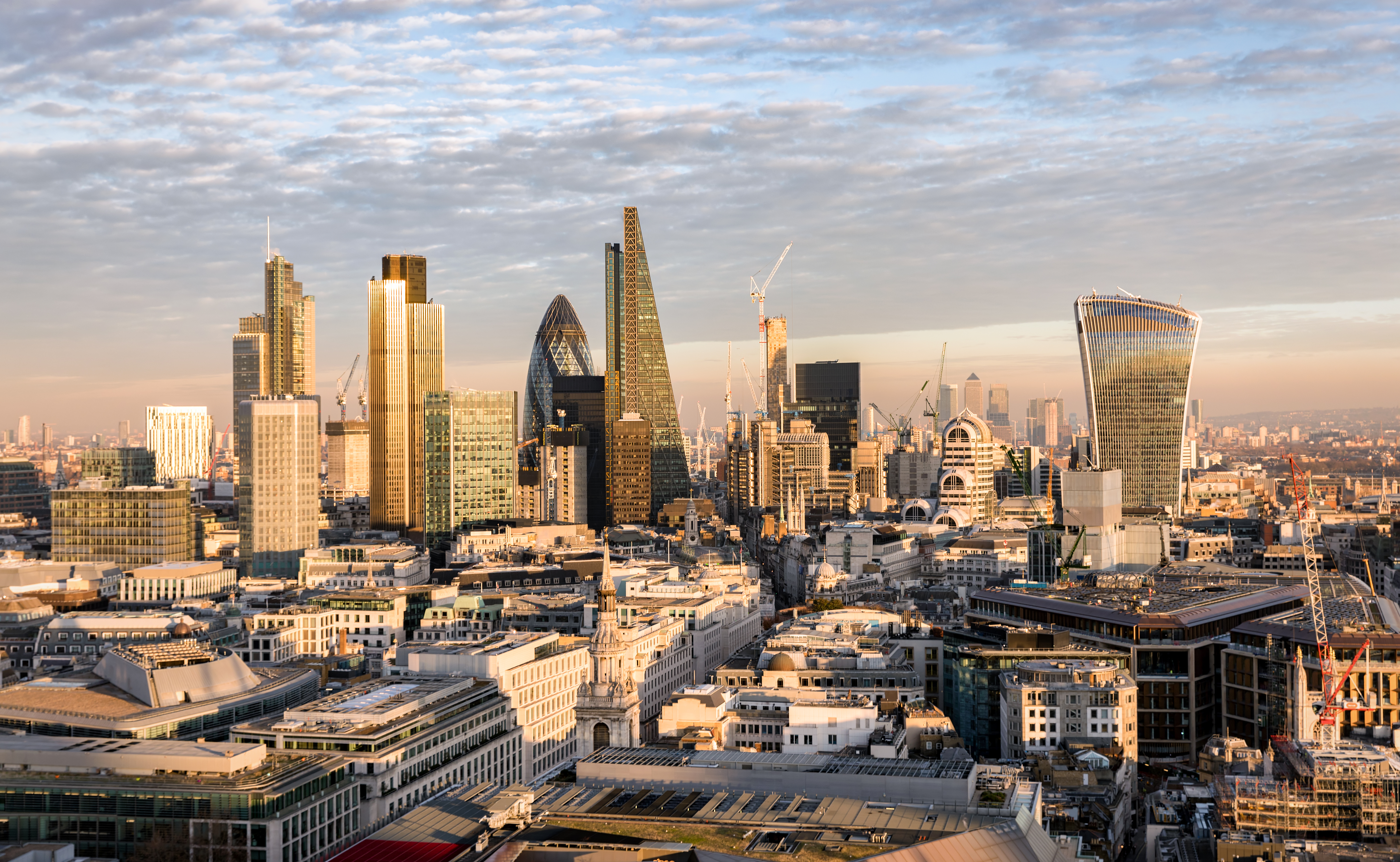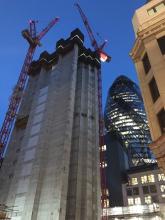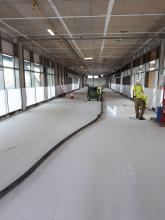
The task for the modern structural engineer or contractor is not an easy one. As the latest building designs become more complicated and budget pressures increase, the onus is on creating cost-effective and sustainable structures which, at the same time, enable scope for greater design freedom than ever before.
Cue the popular use of
As the iconic material celebrates its 60th anniversary, Barry Mellor explains the history of Lytag, the impact it has made on modern construction practice and what the future has in-store.
First conceived by John Laing Ltd and the Building Research Establishment (BRE) in 1958, at a time when architectural design was dominated by huge, exposed concrete structures and the concept of lightweight aggregate was unheard of, Lytag was a ground-breaking innovation which helped to revolutionise the construction industry.
Lytag is made from fly ash generated by coal fired power stations. Using pioneering technology, the fly ash is transformed into round pellets, which are then heated to 1,100°C to create incredibly hard, durable aggregate pellets. Ranging in size from 14mm down to fines, each of the pellets consists of a honeycombed internal structure of interconnecting voids, making Lytag both structurally robust and lightweight.
Thanks to this innovative composition, Lytag is up to 50% lighter than natural quarried aggregate. As a result, contractors and structural engineers using Lytag can benefit from reducing the dead load of their structure, reducing the volume of foundation needed and by using less concrete and steel during the construction process. There are also significant cost savings and environmental benefits associated with Lytag as fewer materials are needed and less transportation is required.
Importantly, the material also provides the same level of structural performance as standard weight concrete, which allows architects to benefit from greater flexibility and has enabled them to break new ground in terms of architectural design.
It’s perhaps not surprising then that Lytag has ‘cemented’ itself a very popular choice for architects, contractors and structural engineers seeking to benefit from the improved design freedom, reduced dead load of structures, substantial cost-savings in materials and improved sustainability.
A lightweight solution to heavyweight problems
Over the last 60 years Lytag has been used in some of the most iconic construction projects in the UK, including the Grandstand at Doncaster Racecourse (1969), the Goodwood Grandstand in Chichester (1980), the Sizewell B Nuclear Power Station in Suffolk (1992), Westminster Bridge (1995), Canary Wharf (2000), the Gherkin (2001) and the Shard (2012).
Its helped developers to make the seemingly ‘impossible’ possible by affording designers great freedom to achieve remarkable architectural feats. By allowing projects to benefit from reducing the number and size of columns, developers have been able to create bigger structures with greater spans, while at the same time being able to reduce the total load of their builds.
The construction of the 70 St Mary Axe landmark development, with its distinctive curvaceous profile, perfectly demonstrates Lytag’s unrivalled ability to deliver a unique lightweight solution to facilitate a novel, ground breaking design. A key requirement for this project was to source a material that would enable vast floor spans to be cast without compromising the dead load of the overall structure. Thanks to its superior lightweight and robust properties, Lytag was able to effectively reduce the composite deck concrete slab load by approximately 25% over normal weight control, whilst offering the same high level of structural performance. The result is an architectural triumph that boasts 300,000sq ft of prime office space with breath-taking views across the city.
Meanwhile, in the case of the Acton Swing Bridge in Cheshire, the bridge was successfully refurbished and reinforced, thanks to Lytag’s ability to increase structural integrity while not increasing mass. By using Lytag to replace the existing infill within the framework, the weight of the Acton Swing Bridge has been reduced dramatically from 2400kg/m³ to 1650kg/m³.
This has resulted in improved flexibility and durability, while also increasing the overall strength of the structure, meaning the bridge is now able to carry heavier road traffic vehicles on the A49 over the River Weaver Navigation. This showcases Lytag’s ability to offer a significant reduction in concrete density and load pressure, which has been a game-changer for numerous sensitive repair programmes and redevelopment projects, including the renovation of Westminster Bridge in 1996 and Wimbledon’s Centre Court redevelopment between 2006-2008.
The greener side of construction
With sustainable building practices continuing to be high on the agenda, Lytag’s environmental credentials has played a crucial role in helping developers to achieve exceptional BREEAM standards in relation to the sustainability performance of their construction projects. As Lytag is made from materials which would otherwise become landfill, it’s classified as a secondary aggregate in accordance with BREEAM specifications and may be counted towards the recycled aggregate content of a build project. It therefore replaces the need for quarried natural aggregate and in doing so can reduce CO₂ emissions by up to 32%, as by being lighter than natural aggregate, it means fewer truck journeys are needed to transport construction materials. Lytag was therefore the stand-out candidate when selecting a building material for the construction of The Convention Centre Dublin, with a core goal of the project to be as environmentally-friendly as possible. The use of Lytag was instrumental in helping the building become the first carbon neutral international convention centre in the world.
Keeping up with the Capital
Lytag has become the building material of choice for major high-rise developments in London over the past six decades. More than 50,000tonnes of Lytag has now been used on high-rise projects in the city and this has had a hugely positive environmental impact by helping to save approximately 25,000tonnes of natural aggregate from being quarried, as well as reducing the need for other secondary materials, such as steel, foundations and piling.
Lytag’s popularity with high-rise developments in London is attributed to its unique lightweight composition and immense structural performance. This has resulted in many high-rise developments being permissible, where previously they could not have been built due to inadequate ground conditions and a reliance on the use traditional quarried aggregate. In fact, the Capital’s skyline could look very different today if it wasn’t for Lytag. It has played a key role in the construction of many of the city’s iconic buildings, such as the Cheese Grater, Tower 42, the Walkie-Talkie, Canary Wharf, the Gherkin and the Shard. What’s more, the prevalence of Lytag in current high-profile developments, such as the prestigious Battersea Power Station redevelopment and impressive 100 Liverpool Street project, demonstrates the success of the brand in this sector and its prowess for bearing the weight of cutting-edge construction projects.
Building on its success
As well as being widely used in London in landmark projects such as 1 Bank Street in Canary Wharf, Lytag is also currently being utilised in various construction projects outside the Capital, including the 26-storey, 103 Colmore Row building, which will become Birmingham’s tallest office development and a captivating landmark for the city. What’s more, the success of recent large-scale, urban regeneration projects, such as Salford Quays in Manchester and Liverpool One, has galvanised the appetite for lightweight concrete, and after 60 years of lightening the load for developers and enabling grand designs, looking to the future, the sky's the limit for Lytag.








